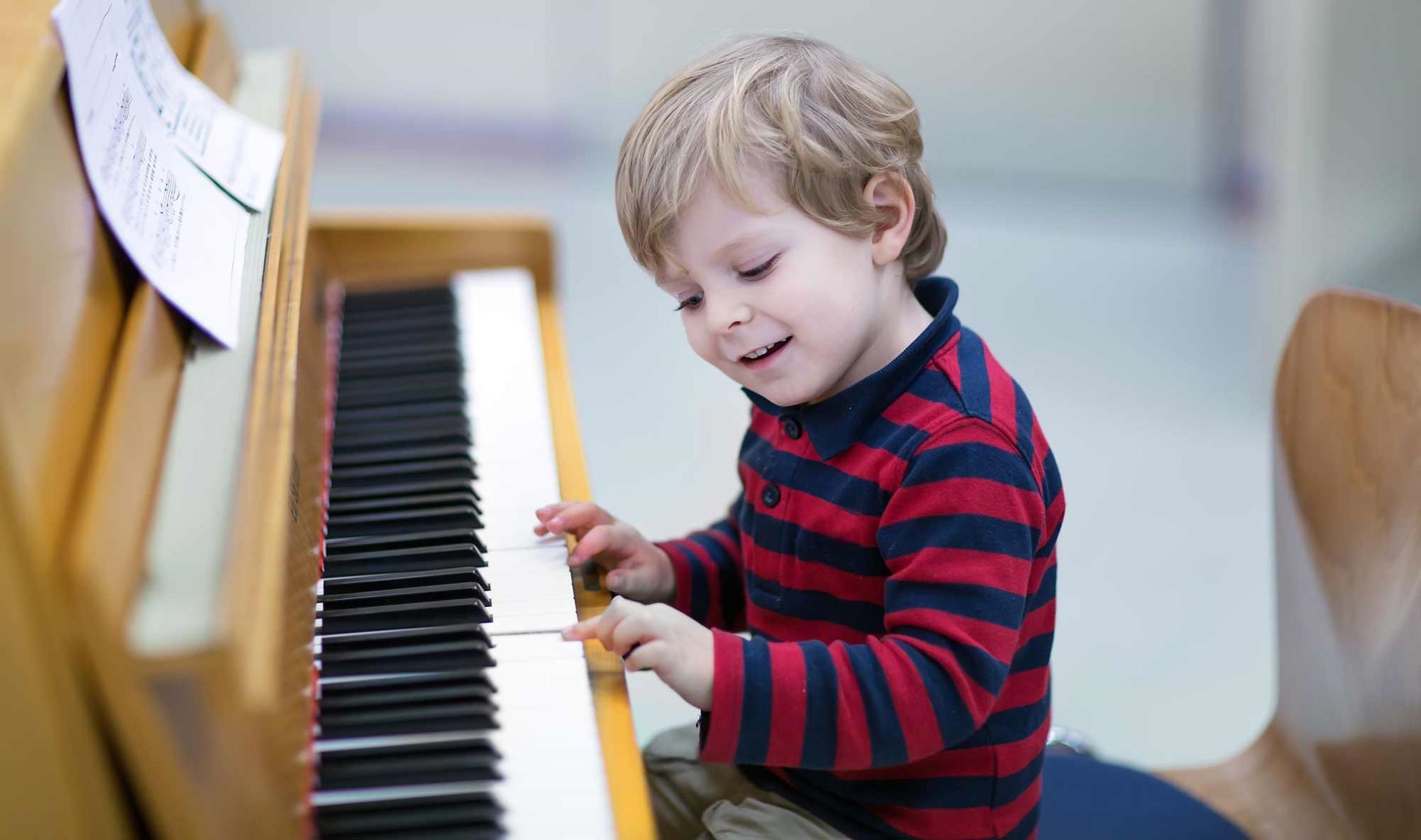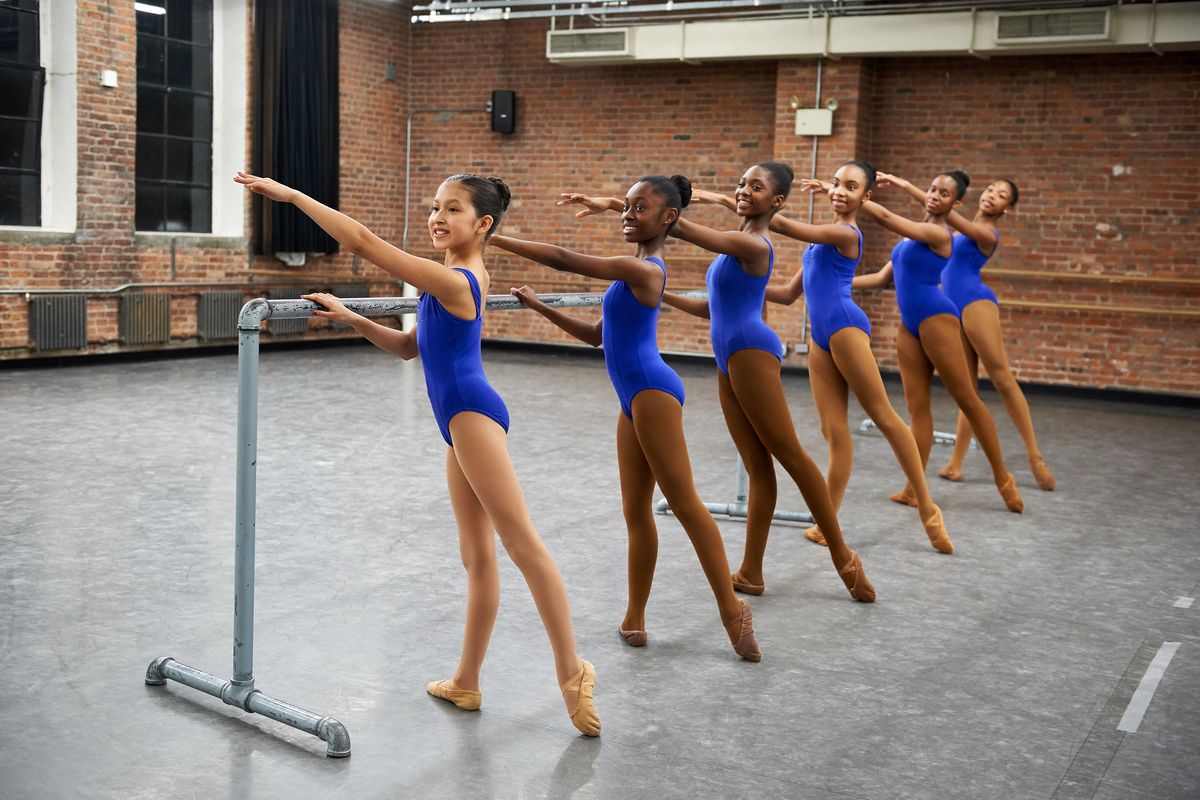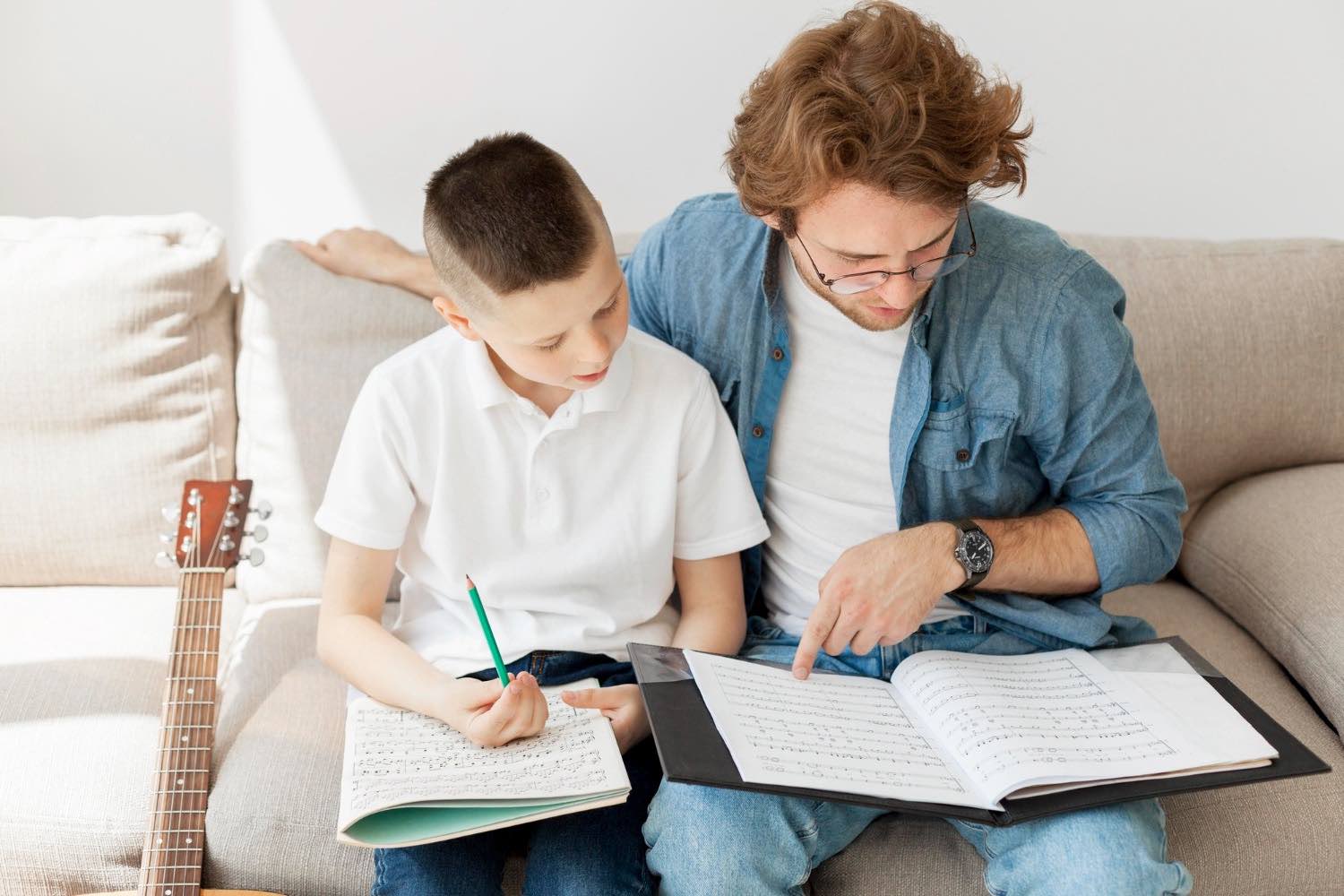Home>Production & Technology>Music Theory>How To Teach Kids Music Theory


Music Theory
How To Teach Kids Music Theory
Published: January 30, 2024
Learn how to teach kids music theory in a fun and engaging way. Discover effective strategies and resources for introducing and mastering the fundamentals of music theory.
(Many of the links in this article redirect to a specific reviewed product. Your purchase of these products through affiliate links helps to generate commission for AudioLover.com, at no extra cost. Learn more)
Table of Contents
- Introduction
- Importance of Teaching Music Theory to Kids
- Basic Concepts of Music Theory
- Tools and Resources for Teaching Music Theory to Kids
- Lesson Plans for Teaching Music Theory to Kids
- Fun and Engaging Activities to Teach Music Theory
- Tips for Effective Music Theory Instruction
- Assessing and Evaluating Kids’ Understanding of Music Theory
- Addressing Challenges and Common Misconceptions in Teaching Music Theory to Kids
- Conclusion
Introduction
Music theory is the foundation of understanding and creating music. It encompasses the study of how music is written, interpreted, and performed. While it may seem like a complex subject, teaching music theory to kids can be both rewarding and beneficial. By giving children a solid understanding of music theory, we not only enhance their musical abilities but also foster their cognitive, emotional, and social development.
Learning music theory from an early age provides children with a strong musical framework. It helps them recognize patterns, understand the relationship between notes, and compose their own music. Moreover, music theory develops critical thinking, problem-solving, and analytical skills, which can be applied to other subjects and areas of life.
By teaching kids music theory, we also nurture their creativity and self-expression. It allows them to explore different musical genres, experiment with melody and harmony, and develop their own unique style. Moreover, understanding the ins and outs of music theory gives children the confidence to pursue a career in music if they choose to do so.
Teaching music theory to kids doesn’t have to be dull or overwhelming. With the right tools, resources, and engaging activities, we can make the learning process enjoyable and interactive. This article will provide a comprehensive guide on how to teach music theory to kids, from basic concepts to effective instructional strategies.
Importance of Teaching Music Theory to Kids
Teaching music theory to kids is crucial for their overall musical development and provides them with a solid foundation for musical exploration. Here are some key reasons why it is important to introduce music theory at an early age:
- Enhances musical skills: Understanding music theory enables kids to read sheet music, play instruments, and sing with accuracy. It helps them grasp concepts like rhythm, tempo, dynamics, and pitch, allowing for more refined and expressive performances.
- Nurtures creativity: By learning music theory, kids gain the tools to compose their own music. They can explore different chord progressions, melody structures, and musical forms, allowing their creative ideas to flourish and be expressed through original compositions.
- Develops critical thinking and problem-solving skills: Music theory involves analyzing and understanding the structure and organization of music. This process cultivates critical thinking skills as children decipher patterns, recognize intervals, and make connections between musical elements. Music theory also encourages problem-solving, as kids overcome challenges in understanding complex music notation and applying techniques to their instrument or voice.
- Expands cognitive abilities: Research has shown that studying music theory enhances cognitive development in children. It helps improve memory, attention span, pattern recognition, and mathematical skills. Music theory engages both hemispheres of the brain, promoting overall cognitive growth.
- Boosts confidence and self-esteem: Mastering music theory empowers children by giving them a sense of accomplishment and pride in their musical abilities. It builds their confidence to perform in front of others, participate in musical ensembles, and pursue further musical opportunities as they grow.
Teaching music theory to kids not only cultivates their musical talents but also benefits their overall academic and personal growth. It enhances their ability to learn and understand complex concepts, fosters teamwork and collaboration in group musical activities, and nurtures discipline and perseverance through regular practice. Music theory equips children with invaluable skills that can be applied throughout their lives, whether in the field of music or in other areas of study and work.
Basic Concepts of Music Theory
Understanding the basic concepts of music theory is essential for kids to build a strong musical foundation. Here are some fundamental concepts that should be introduced:
- Pitch: Pitch refers to how high or low a sound is. It is represented by musical notes on the staff, with higher pitches represented by notes positioned higher on the staff and lower pitches represented by notes positioned lower on the staff.
- Rhythm: Rhythm is the pattern of sounds and silences in music. It is organized into measures and is typically represented by different note values, such as whole notes, half notes, quarter notes, and eighth notes. Understanding rhythm helps children develop a sense of timing and helps them play or sing in sync with others.
- Tempo: Tempo refers to the speed at which the music is played. It can range from slow (grave) to fast (presto), and everything in between. Teaching kids about tempo helps them understand the mood and feel of the music they are playing or listening to.
- Dynamics: Dynamics in music refer to the volume or intensity of the sound. It includes terms like pianissimo (very soft), piano (soft), mezzo piano (moderately soft), forte (loud), and fortissimo (very loud). Understanding dynamics allows children to add expression and emotion to their performances.
- Melody: Melody is the main musical line or tune in a piece of music. It is a sequence of pitches played or sung in succession. Teaching kids about melody helps them recognize recurring patterns and understand how different notes create a cohesive musical idea.
- Harmony: Harmony involves the combination of different pitches played simultaneously to create chords and chord progressions. Teaching kids about harmony helps them understand how chords support the melody and how different chords can create different emotions in music.
- Scales: Scales are a sequence of notes played in ascending or descending order. They provide the foundation for melody and harmony in music. Teaching kids about scales helps them understand the relationship between different notes and helps them develop finger coordination and technique on their instrument.
- Key Signatures: Key signatures indicate the set of pitches used in a musical composition. They determine the tonal center or key of a piece of music. Teaching kids about key signatures helps them understand how to navigate the music and identify the key in which it is written.
These basic concepts of music theory lay the groundwork for further exploration and understanding of music. By introducing these concepts, children gain a solid foundation and vocabulary to analyze, interpret, and create music.
Tools and Resources for Teaching Music Theory to Kids
When it comes to teaching music theory to kids, there are a variety of tools and resources available to make the learning process engaging and interactive. Here are some valuable resources to consider:
- Music Theory Apps: There are numerous music theory apps available for smartphones and tablets that offer interactive lessons, quizzes, and games. Apps like “Music Tutor” and “Musicards” provide a fun way for kids to learn the basics of music theory.
- Music Theory Websites: Online music theory websites, such as “MusicTheory.net” and “Teoria,” offer comprehensive lessons, exercises, and tutorials for kids of all levels. These websites include interactive tools, ear training exercises, and printable worksheets.
- Flashcards: Flashcards are a simple yet effective tool for teaching music theory. Create flashcards with musical notes, symbols, and concepts on one side and their corresponding names or meanings on the other. Use them for drills and quizzes to reinforce learning.
- Worksheets and Workbooks: Printable worksheets and workbooks specifically designed for music theory provide structured exercises and activities. They cover topics like note reading, rhythm recognition, and key signatures, allowing kids to practice and apply their knowledge.
- Musical Instruments: Musical instruments, such as keyboards, guitars, or recorders, can be used as hands-on tools for teaching music theory. Kids can learn about scales, chords, and melodies by playing and experimenting with their instrument under guidance.
- Music Theory Games: Gamifying the learning experience can make it more enjoyable for kids. Board games like “Compose Yourself” and online games like “Music Theory Arcade” provide a fun way for kids to practice music theory concepts while having a great time.
- Music Theory Books: There are numerous music theory books available that cater to kids of different age groups and skill levels. Look for books with clear explanations, engaging illustrations, and interactive exercises to supplement your teaching.
- Software Programs: Music theory software programs, such as “Finale” or “Sibelius,” allow kids to compose music digitally and learn about notation, harmonies, and arranging. These programs provide a comprehensive platform for exploring music theory concepts in a hands-on way.
When utilizing these tools and resources, it’s important to adapt them to the specific needs and learning styles of the children you’re teaching. Incorporating a mix of visual, auditory, and kinesthetic activities and ensuring an interactive and enjoyable experience will greatly enhance the effectiveness of teaching music theory to kids.
Lesson Plans for Teaching Music Theory to Kids
Developing lesson plans for teaching music theory to kids is essential to ensure a systematic and comprehensive approach to their learning. Here are some key elements to consider when creating lesson plans:
- Set Clear Objectives: Begin each lesson by defining clear learning objectives. What specific concepts or skills do you want the kids to grasp by the end of the lesson? For example, the objective could be to identify and name the notes on the staff or to understand the concept of rhythm and note values.
- Introduce Concepts: Introduce new concepts or topics by explaining them in simple and engaging language. Use visuals, such as posters or flashcards, to illustrate the concepts. Break down complex topics into smaller, more accessible parts to ensure understanding.
- Demonstrate and Practice: Provide demonstrations to show how the concepts are applied. For example, demonstrate how to play a specific rhythm pattern on an instrument or vocalize different melodic intervals. Then, allow the children to practice the concepts themselves through activities, exercises, or playing their instruments.
- Provide Hands-on Activities: Incorporate hands-on activities that allow children to engage with the concepts in a fun and interactive way. For example, have them create their own rhythm patterns using rhythm cards or compose their own melodies using a set of notes.
- Use Games and Quizzes: Make learning music theory enjoyable and engaging by incorporating games and quizzes. For example, play a musical version of “Simon Says” to reinforce note recognition or conduct a music theory quiz using flashcards or interactive apps.
- Encourage Creativity: Allow children to express their creativity by giving them opportunities to compose their own music or improvise melodies. This fosters their understanding of musical structure and encourages self-expression.
- Provide Regular Assessments: Regularly assess and evaluate the children’s understanding of the concepts covered. This can be done through informal quizzes, playing or singing exercises, or individual performances. Use these assessments to identify areas where additional review or support may be needed.
- Connect Music Theory to Real-life Examples: Help children understand the practical application of music theory by connecting it to real-life examples. Show how music theory is used in popular songs or in different music genres to deepen their appreciation and relevance.
Remember to adapt the lesson plans to the age and skill level of the children you are teaching. Keep the lessons engaging and interactive, incorporating a mix of activities, games, and hands-on experiences. By using a well-structured and comprehensive lesson plan, you can effectively teach music theory to kids and foster their love and understanding of music.
Fun and Engaging Activities to Teach Music Theory
When teaching music theory to kids, incorporating fun and engaging activities is essential to keep them interested and motivated. Here are some creative activities that make learning music theory enjoyable:
- Musical Charades: Play a game of musical charades where kids act out musical symbols or musical terms, while others guess what they are portraying. This activity helps reinforce their understanding of music theory concepts in a playful and interactive way.
- Rhythm Relay Race: Divide the kids into teams and create a relay race where they have to correctly perform rhythmic patterns by clapping or playing instruments. This activity helps develop their listening skills and rhythmic accuracy.
- Music Bingo: Create a music-themed bingo game using musical symbols, note names, or terms. Kids will have fun listening for the cues and marking the corresponding squares on their bingo cards.
- Compose a Soundtrack: Divide the kids into small groups and have them create a soundtrack for a short video clip or a story. This activity allows them to apply their knowledge of melody, harmony, and dynamics while fostering their creativity.
- Music Scavenger Hunt: Design a music-themed scavenger hunt where kids have to find and identify specific musical notes, symbols, or instruments. This activity encourages active listening and observation skills.
- Musical Mad Libs: Create musical-themed “Mad Libs” style stories where kids fill in the blanks with musical terms, note names, or rhythm patterns. This activity helps reinforce their understanding of music vocabulary and concepts.
- Instrument Petting Zoo: Arrange for a variety of musical instruments to be available for the kids to explore and play with. This hands-on experience allows them to develop an appreciation for different instruments and their unique sounds.
- Musical Trivia: Organize a music trivia game where kids answer questions about famous composers, musical genres, or facts about instruments. This activity tests their knowledge of music history and theory in a fun and competitive way.
- Sing and Move: Incorporate movement and singing into music theory lessons. Have the kids perform simple movements or dance while singing or using solfege to reinforce pitch recognition and vocal technique.
- Musical Freeze Dance: Play music and have the kids dance or move around the room. When the music stops, they must freeze in a musical pose or position related to a specific concept, such as holding a high note or striking a chord.
Remember to adapt these activities to the age and skill level of the children you are teaching. The key is to make learning music theory interactive, imaginative, and enjoyable. By incorporating these fun and engaging activities, you can spark the children’s passion for music and deepen their understanding of music theory.
Tips for Effective Music Theory Instruction
When teaching music theory to kids, it is important to employ effective instructional strategies that cater to their learning needs. Here are some tips to ensure effective music theory instruction:
- Make it relatable: Relate music theory concepts to familiar songs or melodies that the kids already know. This helps them connect new knowledge to existing musical experiences and facilitates understanding.
- Keep it hands-on: Provide hands-on activities and opportunities for kids to actively engage with the concepts. This can include playing instruments, composing melodies, or even conducting their own mini ensembles.
- Encourage creativity: Give children space to experiment and be creative with the concepts they learn. Encourage them to create their own music, improvise melodies, or even rewrite lyrics to popular songs.
- Use technology: Utilize music theory apps, interactive websites, and software programs that allow kids to learn and practice music theory in a fun and interactive way. This can enhance their engagement and provide a multimedia learning experience.
- Provide regular feedback: Offer constructive feedback and praise to encourage kids’ progress and motivate their learning. Recognize their efforts and celebrate their accomplishments to boost their confidence in applying music theory concepts.
- Individualize instruction: Recognize that each child learns at their own pace and has unique learning preferences. Tailor your instruction to accommodate different learning styles and provide additional support or challenges as needed.
- Use visuals and diagrams: Visual aids such as posters, charts, and diagrams can help children visualize and understand abstract music theory concepts. Use them to illustrate note values, intervals, and key signatures.
- Connect theory to practice: Regularly relate music theory concepts to practical applications. For example, explain how understanding rhythm helps in playing a particular instrument or how knowledge of key signatures aids in sight-reading.
- Break it down: Break complex concepts into smaller, more manageable parts. Teach one concept at a time, ensuring understanding before moving on. Gradually build upon previously learned concepts to create a solid foundation.
- Make it fun: Infuse enthusiasm, energy, and creativity into your lessons. Incorporate games, activities, and interactive exercises that make learning music theory enjoyable and memorable for the kids. The more they enjoy the learning process, the more likely they are to retain and apply what they have learned.
Remember that effective instruction is a balance between providing structure and guidance while allowing room for exploration and creativity. By incorporating these tips, you can create a positive and engaging learning environment where children can develop a strong understanding and appreciation of music theory.
Assessing and Evaluating Kids’ Understanding of Music Theory
Assessing and evaluating kids’ understanding of music theory is crucial to gauge their progress and identify areas that may need further reinforcement. Here are some effective methods for assessing and evaluating their understanding:
- Observation: Observe the kids during class activities, such as playing instruments, singing, or participating in group exercises. Note their ability to apply music theory concepts and their overall comprehension of the material.
- Informal Quizzes: Incorporate quick quizzes throughout the lessons to check their understanding of music theory concepts. Use flashcards, worksheets, or interactive quizzes to assess their knowledge of note names, rhythm patterns, or key signatures.
- Playing or Singing Assessments: Have the kids individually play or sing assigned pieces that incorporate the music theory concepts covered in class. Evaluate their accuracy, technique, and interpretation to gauge their understanding and application of the concepts.
- Composition Assignments: Assign composition projects where kids create their own short melodies or chord progressions. Assess their compositions based on their adherence to specific music theory rules and their ability to apply the concepts taught.
- Listening Assessments: Play recorded musical excerpts or compositions and ask the kids to identify specific music theory elements, such as intervals, dynamics, or chord progressions. Evaluate their ability to recognize and describe these elements.
- Written Examinations: Administer written exams that test kids’ knowledge of music theory concepts. Include questions on note reading, rhythm recognition, key signatures, and other relevant topics. Assess their understanding through their written responses.
- Performance Assessments: Arrange performance opportunities where kids showcase their skills in playing instruments or singing. Evaluate their performances based on their technical accuracy, musical expression, and understanding of the music theory concepts incorporated in their performance.
- Peer Feedback and Self-Assessment: Encourage peer feedback and self-assessment. Have the kids listen to each other’s performances or compositions and provide constructive feedback based on music theory concepts. This encourages self-reflection and critical thinking.
- Progress Check-ins: Regularly check-in with each child to assess their understanding and address any individual challenges they may be facing. This can be done through one-on-one discussions, mini quizzes, or informal conversations about their progress.
- Portfolios: Create portfolios that compile the kids’ work, including compositions, worksheets, and recordings of their performances. Regularly review and evaluate their portfolios to monitor their progress and growth over time.
Remember to provide constructive feedback to the kids based on their assessments. Highlight their strengths and areas for improvement, and guide them on how to enhance their understanding of music theory. Assessments should not only measure their knowledge but also serve as tools for continuous learning and growth.
Addressing Challenges and Common Misconceptions in Teaching Music Theory to Kids
Teaching music theory to kids can sometimes come with challenges and common misconceptions. Here are some ways to address these challenges and ensure a more effective learning experience:
- Engaging visual and auditory aids: Incorporate visual aids such as posters, charts, and diagrams to reinforce abstract concepts. Additionally, use audio examples and recordings to help children develop their listening skills and musical ear.
- Adapt teaching methods to different learning styles: Recognize that each child has their own preferred learning style. Provide a variety of teaching methods, including visual, auditory, and kinesthetic activities, to cater to different learning preferences.
- Break down complex concepts: Music theory can be overwhelming for kids, so break down complex concepts into smaller, more digestible parts. Start with the basics and build upon them gradually, ensuring that each concept is fully understood before moving on to the next.
- Repetition and reinforcement: Reinforce concepts through repetition and frequent review. Use various activities and exercises to reinforce knowledge and skills, ensuring that children have ample opportunities to practice and apply what they have learned.
- Provide practical examples: Relate music theory concepts to practical examples that kids can understand and relate to. For instance, explain how rhythms can be found in everyday activities like walking or clapping hands.
- Encourage questions and active participation: Create a safe and supportive learning environment where kids feel comfortable asking questions. Encourage active participation and discussion to clarify any misconceptions they may have.
- Address individual challenges: Recognize that not all kids grasp concepts at the same pace. Provide individual support to those who may be struggling, offering additional explanations, examples, or one-on-one practice sessions to help them catch up.
- Use real-life applications: Connect music theory with real-life applications to make it more relevant and relatable. Demonstrate how music theory concepts are used in popular songs or in different musical genres, reinforcing the practical significance of their learning.
- Celebrate achievements: Recognize and celebrate the accomplishments and progress of each child. Positive reinforcement boosts their confidence and motivates them to continue their music theory journey with enthusiasm.
- Promote a growth mindset: Foster a growth mindset by emphasizing that learning music theory is a journey and that mistakes and challenges are part of the learning process. Encourage kids to embrace challenges as opportunities for growth and improvement.
By addressing these challenges and misconceptions through thoughtful teaching strategies and creating a supportive learning environment, you can help kids overcome obstacles and develop a strong understanding and appreciation for music theory.
Conclusion
Teaching music theory to kids is a valuable endeavor that not only enhances their musical skills but also nurtures their cognitive, emotional, and social development. By providing children with a solid understanding of music theory, we empower them to read and create music, develop critical thinking skills, and express themselves creatively.
Throughout this article, we have explored the importance of teaching music theory to kids and how it serves as the foundation for their musical journey. We have discussed the basic concepts of music theory, including pitch, rhythm, tempo, melody, harmony, and more. We have also explored various tools, resources, and engaging activities that can be used to make music theory instruction fun and interactive.
In order to effectively teach music theory to kids, it is important to set clear objectives, incorporate hands-on activities, and make use of technology and visual aids. Regular assessments and evaluations help monitor progress and identify areas that need further reinforcement. By addressing challenges and common misconceptions, we can create a nurturing learning environment where kids can thrive.
Teaching music theory to kids is a journey that requires patience, creativity, and adaptability. By fostering their love and understanding of music, we inspire them to pursue their musical passions and lay the foundation for a lifelong appreciation of the art.
So let’s embark on this journey together, equipping kids with the knowledge and skills they need to explore, create, and embrace the magical world of music.











